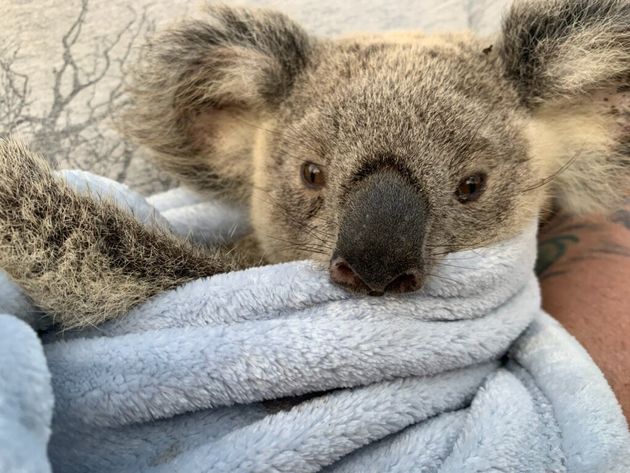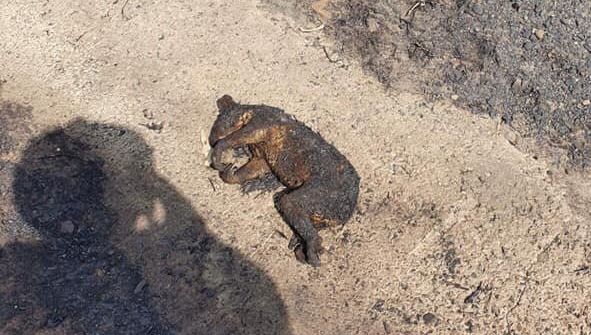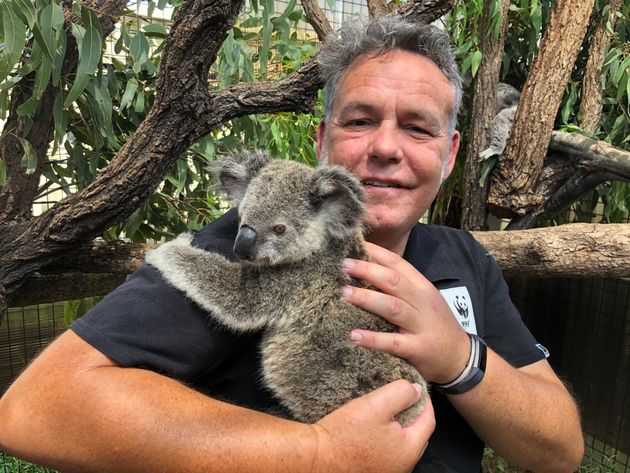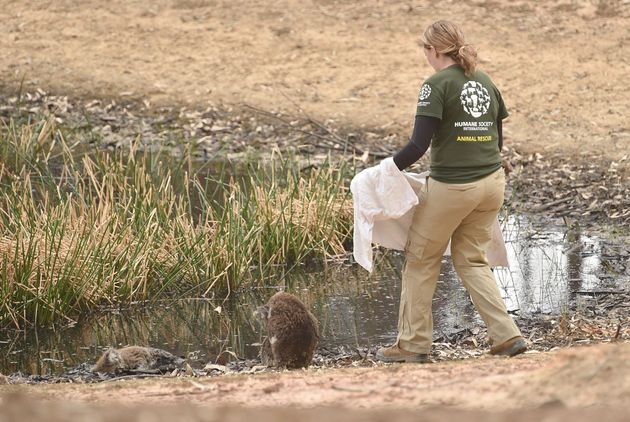The baby koala named Maryanne lost her mother and a claw, and suffered severe burns on the pads on her feet when Australia’s wildfires destroyed her southeast Queensland habitat.
Peter Luker, a volunteer firefighter and animal caretaker with the Ipswich Koala Protection Society, has seen horrific things this fire season ― but currently has the pleasure of watching little Maryanne make a full recovery.
In early December, a frustrated Luker shared a graphic photo of a charred koala he’d come across as he helped fight the Wivenhoe Pocket fire to demonstrate the horrors of this fire season. The heartbreaking post went viral and was liked and shared tens of thousands of times.
In the new year, Luker is sharing a more positive story from that same blaze. He and his partner, Trudi Timbs, took on Maryanne after she suffered her injuries a week before Christmas, most likely from walking over hot coals or climbing a burning tree.

“It’s like having the palms of your hands burnt off; she would have been in incredible pain,” Luker said.
After first receiving emergency treatment at the RSPCA Queensland Wildlife Hospital, the little joey is on the mend in the care of Luker and Timbs ― and delighting those who have the pleasure of meeting her.
She’ll stay with her caretakers until she’s gained more weight, and after some time in a pre-release area she’ll be released back into the wild.

The World Wide Fund for Nature-Australia (WWF) has so far committed more than $1.1 million for the immediate rescue, care and recovery of wildlife, with RSCPA Queensland one of the first recipients due to the state’s early bushfire season and a subsequent influx of injured animals like Maryanne.
The hospital’s average daily intake is continuing to be around 80 animals a day.
“That has put a huge strain on the organisation and particularly the people who are working in the wildlife hospital,” said RSPCA Queensland CEO Darren Maier.
The federal government has also pledged $50 million nationwide to help wildlife affected by the fires.

WWF Australia is partnering with various groups to provide both an immediate response to the disaster and establish long-term restoration plans, CEO Dermot O’Gorman said.
In Queensland alone, close to 10,000 square miles (2.5 million hectares) have been burned. State environment minister Leeanne Enoch said the scale and ferocity were “unprecedented.”
“We are working on a state-wide figure for wildlife impacted, but for koalas alone, (the Department of Environment and Science) believes that up to 7% of core koala habitat in southeast Queensland could have been impacted by the fires,” she said.

In the hardest-hit states of Victoria and New South Wales, fires have scorched around 5,000 and 20,000 square miles, respectively. At this stage, about one-quarter of the modelled koala habitat in eastern New South Wales is within the fire-affected area, an environment department spokesperson said.
Dr. Jenny Gray, CEO of Zoos Victoria, said that with fires still active, the full extent of impact to wildlife in the state remains unknown ― “except to know it will be extensive.”
She said that dozens of koalas were coming through triage with varying levels of injury severity, with some recovering quickly from smoke inhalation while others need longer-term critical care.
In one heartwarming snap from the zoo’s Mallacoota triage center, two orphaned koalas are seen doing well in their “joey creche.”
“From heartbreak comes hope. These two joeys lost their mothers in the fire but were well protected by them and as a result, suffered little injuries,” the center wrote on Facebook.
Other footage shows three bushfire-surviving koalas, Spinach, Vicky and Leafy, making progress at Victoria’s Healesville Sanctuary. They, too, will most likely be able to return to the wild, officials said.
Spinach, termed by zoo workers the “bravest of the three,” suffered extensive burns to his eyes, nose, ears and paws. However, the workers said he is “strong and he’s not giving up” and he can be seen eagerly knocking back a tube of eucalyptus-leaf paste.
“These are just three of the thousands of animals that need your support,” the zoo wrote.
On Kangaroo Island, where around half of the island’s 50,000 koala population is estimated dead, rescuers are continuing to find dehydrated and traumatized animals weeks after the blazes.
“The survivors have little to no energy reserves left and we are finding them sitting on the ground totally shut down – all too often with other corpses nearby,” said Kelly Donithan, a Humane Society International disaster response specialist.

On the island, where around half of the habitat is gone, the struggle is not only nursing these animals back to health, but finding alternative homes while their natural food sources grow back.
Recently, a tragic image went viral of a “shut down” koala that looked as though it was grieving beside a dead companion on the island. Donithan rescued that traumatized koala, and said she is now “doing well in emergency rehab.”
You can support some of the organizations saving wildlife by donating to the Nature Foundation’s Wildlife Recovery Fund, WWF Australia, NSW-based animal rescue group Wildlife Information Rescue and Education Service (WIRES), Zoos Victoria’s bushfire emergency wildlife fund, Australia Zoo’s Wildlife Hospital, or Port Macquarie Koala Hospital.